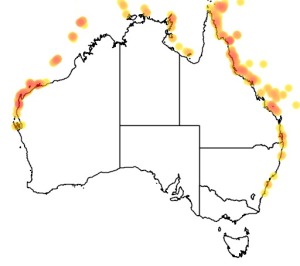
©Andy Lewis: A juvenile Two-line Monocle Bream with a large parasitic isopod attached just behind the eye. Juvenile colouration mimics the venomous fangblenny Meiacanthus lineatus.
Colours
Distinguishing features
A medium sized fish with grey upperparts and white below. Two distinct dark lines curve from behind the eye to the start of the soft dorsal fin, and there are threee yellow lines on the head. The juvenile is dark above, pale below with 2 yellow lines running along the upper back and a dark spot on the dorsal fin.
Size
- Up to 23 cm (Standard length)
Depth range
- Depth range data is not yet available.
Synonyms
Distribution
Distribution and habitat preferences
Areas of rich coral growth with nearby areas of sand and rubble for feeding.
Can be found in most locations around the island.
Behaviour
The Two-line Monocle Bream feeds at night time on invertebrates in the sand and rubble borders around coral reefs, and consequently picks up high loads of ectoparasites. During the day it rests over the reef without much activity, frequently being cleaned by the Common Cleanerfish. The fish has a similar feeding habit to the Emperors, in that it forages in a jerky, stop-start manner, moving for short distances, stopping and observing the bottom, and then taking a rapid bite. Ingested sand is filtered out through the gills. These fishes are protogynous hermaphrodites, starting life as females and then switching to males at larger sizes. They mature at about 1 year old and live for about 5 years. The small juveniles mimic the toxic fangblennies in the genus Meiacanthus.
Web resources
References
- Arnal, C. (2000). Ecologie comportementale de la symbiose poisson nettoyeur/ poisson client: motivations et honnêteté, Ph.D. thesis, University of Perpignan, France. LIRS catalog number 637.
- Binning, S.A. (2014). The effects of biotic and abiotic factors on fish swimming performance. PhD thesis, Australian National University. LIRS catalog number 1769.
- Binning, S.A., J.I. Barnes, J.N. Davies, P.R.Y. Backwell, J.S. Keogh and D.G. Roche (2014). Ectoparasites modify escape behaviour, but not performance, in a coral reef fish, Animal Behaviour, 93: 1-7. LIRS catalog number 1834.
- View all references



